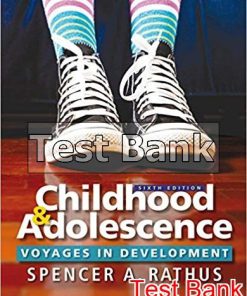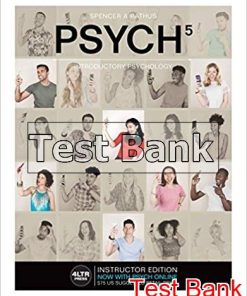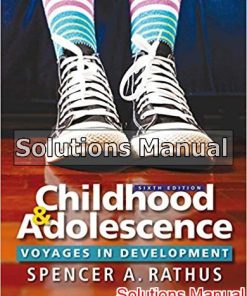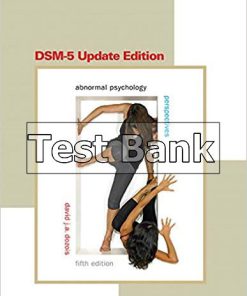Childhood Voyages in Development 5th Edition Rathus Test Bank
You may also like
-
$26.50
$50.00
Childhood Voyages in Development 5th Edition Rathus Test Bank
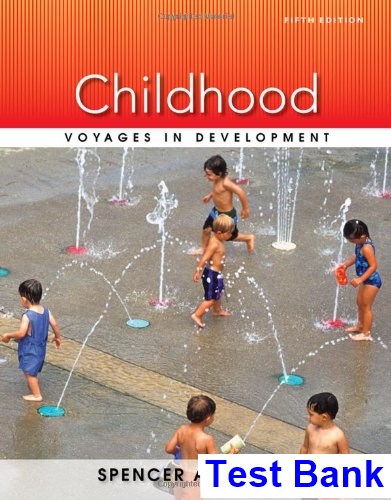
Product details:
- ISBN-10 : 1133956475
- ISBN-13 : 978-1133956471
- Author: Spencer A. Rathus
Spencer A. Rathus provides a hands-on approach in the chronologically organized CHILDHOOD: VOYAGES IN DEVELOPMENT, Fifth Edition, helping you understand the links between developmental theories and research–and their application to everyday life. Using his proven pedagogical approach, interspersed with personal and humorous stories, Rathus makes reading and studying an enjoyable process of discovery.
Table contents:
Machine generated contents note: pt. 1 What Is Child Development?
1. History, Theories, and Methods
Truth or Fiction?
1.1. What Is Child Development? Coming to Terms with Terms
Why Do We Study Child Development?
The Development of Child Development
1.2. Theories of Child Development
What Are Theories of Child Development?
The Psychoanalytic Perspective
Concept Review 1.1 Comparison of Freud’s and Erikson’s Stages of Development
The Learning Perspective: Behavioral and Social Cognitive Theories
A Closer Look: Research The Bell-and-Pad Method for Treating Bed-Wetting
A Closer Look: Research Operant Conditioning of Vocalizations in Infants
The Cognitive Perspective
Concept Review 1.2 Jean Piaget’s Stages of Cognitive Development
The Biological Perspective
The Ecological Perspective
The Sociocultural Perspective
Observing Children, Understanding Ourselves Zone of Proximal Development. Contents note continued: Concept Review 1.3 Perspectives on Child-Development
1.3. Controversies in Child Development
The Nature-Nurture Controversy
The Continuity-Discontinuity Controversy
The Active-Passive Controversy
1.4. How Do We Study Child Development?
The Scientific Method
Methods of Observation
A Closer Look: Research Surveying High School Seniors’ Attitudes toward Living Together before. Getting Married
Correlation: Putting Things Together
The Experiment: Trying Things Out
Longitudinal Research: Studying Development over Time
Concept Review 1.4 Comparison of Cross-Sectional, Longitudinal, and Cross-Sequential Research
1.5. Ethical Considerations
A Closer Look: Research The Conditioning of “Little Albert”: A Case Study in Ethics
Recite: An Active Summary
Key Terms
Active Learning Resources
pt. 2 Beginnings
2. Heredity and Conception
Truth or Fiction? Contents note continued: 2.1. The Influence of, Heredity on Development: The Nature of Nature
Chromosomes and Genes
Mitosis and Meiosis
Identical and Fraternal Twins
Dominant and Recessive Traits
2.2. Chromosomal and Genetic Abnormalities
Chromosomal Abnormalities
Genetic Abnormalities
Genetic Counseling and Prenatal Testing
Observing Children, Understanding Ourselves Prenatal Assessment
2.3. Heredity and the Environment: Nature versus Nurture
Reaction Range
Canalization
Genetic-Environmental Correlation
Kinship Studies: Are the Traits of Relatives Related?
Twin Studies: Looking in the Genetic Mirror
Observing Children, Understanding Ourselves Twins
Adoption Studies
2.4. Conception: Against All Odds
Ova
A Closer Look: Diversity Where Are the Missing Chinese Girls?
Sperm Cells
2.5. Infertility and Assisted Reproductive Technology
Causes of Infertility
A Closer Look: Diversity LGBT Family Building. Contents note continued: Helping People with Fertility Problems Become Parents
A Closer Look: Research Selecting the Sex of Your Child: Fantasy or Reality?
Recite: An Active Summary
Key Terms
Active Learning Resources
3. Prenatal Development
Truth or Fiction?
3.1. The Germinal Stage: Wanderings
Without Visible Means of Support ..
3.2. The Embryonic Stage
A Closer Look: Real Life Selecting an Obstetrician
Sexual Differentiation
The Amniotic Sac: A Shock Absorber
The Placenta: A Filtration System
3.3. The Fetal Stage
A Closer Look: Research On Fetal Perception
-Bach at Breakfast and Beethoven at Brunch?
Concept Review 3.1 Highlights of Prenatal Development
A Closer Look: Diversity Birth Rates around the World
3.4. Environmental Influences on Prenatal Development
Nutrition
A Closer Look: Real Life Advice for. Expectant Fathers
Teratogens and Health Problems of the Mother. Contents note continued: A Closer Look: Real Life Preventing One’s Baby from Being Infected with HIV
Drugs Taken by the Parents
Observing Children, Understanding Ourselves Antidepressants in Utero
A Closer Look: Research Can We Trust the Research on the Effects of Caffeine Taken during Pregnancy?
Environmental Hazards
Maternal Stress
Concept Review 3.2 Risks of Various Agents to the Embryo and Fetus
A Closer Look: Diversity The Effects of Parents’ Age on Children
-Do Men Really Have All the Time in the World?
Recite: An Active Summary
Key Term
Active Learning Resources
4. Birth and the Newborn Baby: In the New World
Truth or Fiction?
4.1. Countdown ..
4.2. The Stages of Childbirth
The First Stage
The Second Stage
The Third Stage
Observing Children, Understanding Ourselves Birth
4.3. Methods of Childbirth
Anesthesia
Hypnosis and Biofeedback
Prepared Childbirth
Cesarean Section
Home Birth
4.4. Birth Problems. Contents note continued: Oxygen Deprivation
Preterm and Low-Birth-Weight Infants
A Closer Look: Diversity Maternal and Infant Mortality around the World
4.5. The Postpartum Period
Maternal Depression
Bonding
A Closer Look: Research Have We Found the Daddy Hormones?
4.6. Characteristics of Neonates
Assessing the Health of Neonates
Reflexes
Observing Children, Understanding Ourselves
Reflex Development in Infancy
Sensory Capabilities
A Closer Look: Research Studying Visual Acuity in Neonates
-How Well Can They See?
Learning: Really Early Childhood “Education”
Observing Children, Understanding Ourselves
Early Learning
Sleeping and Waking
Crying
4.7. Sudden Infant Death Syndrome (SIDS)
The Children’s Hospital Boston Study
Recite: An Active Summary
Key Terms
Active Learning Resources
pt. 3 Infancy
5. Infancy: Physical Development
Truth or Fiction?
5.1. Physical Growth and Development. Contents note continued: Sequences of Physical Development: Head First?
Concept Review 5.1 Sequences of Physical Development
Growth Patterns in Height and Weight: Heading-toward the Greek Ideal?
Failure to Thrive
5.2. Nutrition: Fueling Development
A Closer Look: Real Life Food Timeline for the First Two Years
Breast Feeding versus Bottle Feeding: Pros and Cons, Biological and Political
A Closer Look: Diversity Wasting Away from Hunger
5.3. Development of the Brain and Nervous System
Development of Neurons
Development of the Brain
Nature and Nurture in the Development of the Brain
5.4. Motor Development: How Moving
Observing Children, Understanding Ourselves
Early Gross Motor Development
Lifting and Holding the Torso and Head: Heads Up
Control of the Hands: Getting a Grip on Things
Locomotion: Getting a Move On
Nature and Nurture in Motor Development
5.5. Sensory and Perceptual Development: Taking In the World. Contents note continued: Development of Vision: The Better to See You With
Observing Children, Understanding Ourselves
The Visual Cliff
Development of Hearing: The Better to Hear You With
A Closer Look: Research Strategies for Studying the Development of Shape Constancy
A Closer Look: Real Life Effects of Early Exposure to Garlic, Alcohol and Gulp-Veggies
Development of Coordination of the Senses: If I See It, Can I Touch It?
Observing Children, Understanding Ourselves
Sensation and Perception in Infancy
The Active-Passive Controversy in Perceptual Development
Nature and Nurture in Perceptual Development
Recite: An Active Summary
Key Terms
Active Learning Resources
6. Infancy: Cognitive Development
Truth or Fiction?
6.1. Cognitive Development: Jean Piaget
The Sensorimotor Stage
Observing Children, Understanding Ourselves
Piaget’s Sensorimotor Stage
Development of Object Permanence. Contents note continued: Concept Review 6.1 The Six Substages of the Sensorimotor Stage, According to Piaget
A Closer Look: Research Orangutans, Chimps, Magpies, and Object Permanence
Evaluation of Piaget’s Theory
A Closer Look: Research Counting in the Crib? Findings from a “Mickey Mouse Experiment”
6.2. Information Processing
Infants’ Memory
Imitation: Infant See, Infant Do?
A Closer Look: Research On Mirror Neurons and Really Early Childhood Imitation
6.3. Social Influences on Early Cognitive Development
6.4. Individual Differences in Cognitive Functioning among Infants
Testing Infants: Why and with What?
Instability of Intelligence Scores Attained in Infancy
Use of Visual Recognition Memory: An Effort to Enhance Predictability
6.5. Language Development
Early Vocalizations
Development of Vocabulary
A Closer Look: Diversity Babbling Here, There, and Everywhere
A Closer Look: Real Life Teaching Sign Language to Infants. Contents note continued: Development of Sentences: Telegraphing Ideas
6.6. Theories of Language Development: Can You Make a Houseplant Talk?
Views That Emphasize Nurture
A Closer Look: Diversity Two-Word Sentences Here, There, and ..
Enhancing Language Development
Views That Emphasize Nature
Recite: An Active Summary
Key Terms
Active Learning Resources
7. Infancy: Social and Emotional Development
Truth or Fiction?
7.1. Attachments: Bonds That Endure
Patterns of Attachment
Establishing Attachment
Observing Children, Understanding Ourselves
Early Attachment and Anxiety
Stability of Attachment
Stages of Attachment
Theories of Attachment
Observing Children, Understanding Ourselves
The Social Smile
Concept Review 7.1 Theories of Attachment
7.2. When Attachment Fails
Social Deprivation
Child Abuse and Neglect
A Closer Look: Real Life Prevention of Sexual Abuse of Children. Contents note continued: A Closer Look: Research How Child Abuse May Set the Stage for Psychological Disorders in Adulthood
Autism Spectrum Disorders: Alone among the Crowd
7.3. Day Care
A Closer Look: Real Life Finding Child Care You (and Your Child) Can Live With
7.4. Emotional Development
Observing Children, Understanding Ourselves
Emotional Development
Emotional Development and Patterns of Attachment
Fear of Strangers
Social Referencing: What Should I Do Now?
Emotional Regulation: Keeping on an Even-Keel
7.5. Personality Development
The Self-Concept
Temperament: Easy, Difficult, or Slow to Warm Up?
7.6. Gender Differences
Observing Children, Understanding Ourselves
Gender
Behavior of Infant Girls and Boys
Adults’ Behaviors toward Infant Girls and Boys
Parents’ Behaviors toward Sons and Daughters
Recite: An Active Summary
Key Terms
Active Learning Resources
pt. 4 Early Childhood. Contents note continued: 8. Early Childhood: Physical Development
Truth or Fiction?
8.1. Growth Patterns
Height and Weight
Development of the Brain
8.2. Motor Development
Gross Motor Skills
Observing Children, Understanding Ourselves
Gross Motor Skills
Physical Activity
A Closer Look: Diversity Gender Differences in Motor Activity
Observing Children, Understanding Ourselves
Fine Motor Skills
Fine Motor Skills
Children’s Drawings
Handedness: On Being Right or … Left?
8.3. Nutrition
Nutritional Needs
Patterns of Eating
8.4. Health and Illness
Minor Illnesses
Major Illnesses
A Closer Look: Real Life Ten Things You Need to Know about Immunizations
Accidents
A Closer Look: Real Life Protecting Children from Lead Poisoning
8.5. Sleep
Sleep Disorders
A Closer Look: Research Cross-Cultural Differences in Sleeping Arrangements
8.6. Elimination Disorders
Enuresis
Encopresis. Contents note continued: A Closer Look: Real Life What to Do about Bed-Wetting
Recite: An Active Summary
Key Terms
Active Learning Resources
9. Early Childhood: Cognitive Development
Truth or Fiction?
9.1. Jean Piaget’s Preoperational Stage
Symbolic Thought
Symbolic or Pretend Play: “We Could Make Believe”
Operations: “Transformers” of the Mind
Egocentrism: It’s All about Me
Causality: Why? Because
Confusion of Mental and Physical Events: On “Galaprocks” and Dreams That Are Real
Observing Children, Understanding Ourselves
Piaget’s Preoperational Stage
Focus on One Dimension at a Time: Mental Blinders
Evaluation of Piaget
Concept Review 9.1 Features-of Preoperational Cognition According to Piaget
A Closer Look: Diversity Development of Concepts of Ethnicity and Race
9.2. Vygotsky’s Views on Early Childhood Cognitive Development. Contents note continued: A Closer Look: Research-Effects of Scaffolding on Children’s Abilities to Recall and Retell Stories
Scaffolding and the Zone of Proximal Development
9.3. Other Factors in Early Childhood Cognitive Development: The Home Environment, Preschool, and Television
The Effect of the Home Environment
Early Childhood Education
Television: Window on the World or Prison within a False World?
A Closer Look: Real Life Helping Children Use Television Wisely
9.4. Theory of Mind: What Is the Mind? How Does It Work?
False Beliefs: Just Where Are Those Crayons?
Origins of Knowledge: Where Does It Come From?
The Appearance-Reality Distinction: Appearances Are More Deceiving at Some Ages Than at Others
9.5. Development of Memory: Creating Documents, Storing Them, Retrieving Them
Memory Tasks: Recognition and Recall
Competence of Memory in Early Childhood
Factors Influencing Memory
Memory Strategies: Remembering to Remember. Contents note continued: 9.6. Language Development: Why “Daddy Goed Away”
Development of Vocabulary: Words, Words, and More Words
Development of Grammar: Toward More Complex Language
Observing Children, Understanding Ourselves
An Explosion in Vocabulary
Pragmatics: Preschoolers Can Be Practical
Language and Cognition
Recite: An Active Summary
Key Terms
Active Learning Resources
10. Early Childhood: Social and Emotional Development
Truth or Fiction?
10.1. Influences on Development: Parents, Siblings, and Peers
Dimensions of Child Rearing
How Parents Enforce Restrictions
Parenting Styles: How Parents Transmit Values and Standards
Effects of the Situation and the Child on Parenting Styles
Influence of Siblings
A Closer Look: Diversity-Individualism, Collectivism, and Patterns of Child Rearing
Birth Order: Not Just Where in the World But Also Where in the Family
Peer Relationships. Contents note continued: A Closer Look: Diversity Where Are the Missing American Fathers?
10.2. Social Behavior: In the World, among Others
Play
-Child’s Play, That Is
Observing Children, Understanding Ourselves
Types of Play
Observing Children, Understanding Ourselves
Early Childhood Play
Prosocial Behavior: It Could Happen! And It Does
A Closer Look: Research Do You Have to Be Taught to Hate?
Development of Aggression: The Dark Side of Social Interaction
Theories of Aggression
10.3. Personality and Emotional Development
The Self
Initiative versus Guilt
Fears: The Horrors of Early Childhood
A Closer Look: Real Life Helping Children Cope with Fears
10.4. Development of Gender Roles and Gender Differences
Gender Differences
Theories of the Development of Gender Differences
Observing Children, Understanding Ourselves
Gender
Concept Review 10.1 Theories of the Development of Gender Differences. Contents note continued: Recite: An Active Summary
Key Terms
Active Learning Resources
pt. 5 Middle Childhood
11. Middle Childhood: Physical Development
Truth or Fiction?
11.1. Growth Patterns
Brain Development
Nutrition and Growth
Gender Similarities and Differences in Physical Growth
Vision and Hearing
11.2. Overweight Children
Observing Children, Understanding Ourselves
Childhood Obesity
Causes of Being Overweight
A Closer Look: Real Life Helping Overweight Children Manage Their Weights
11.3. Childhood Asthma
11.4. Motor Development
Gross Motor Skills
Observing Children, Understanding Ourselves
Middle Childhood: Gross Motor Skills
Fine Motor Skills
Gender Similarities and Differences in Motor Development
Concept Review 11.1 Development of Motor Skills during Middle Childhood
Exercise and Fitness
11.5. Disorders That Affect Learning
Attention-Deficit/Hyperactivity Disorder (ADHD). Contents note continued: A Closer Look: Diversity African American Youth and ADHD
Learning Disabilities
Concept Review 11.2 Kinds of Learning Disabilities
Communication Disorders
Recite: An Active Summary
Key Terms
Active Learning Resources
12. Middle Childhood: Cognitive Development
Truth or Fiction?
12.1. Piaget: The Concrete-Operational Stage
Conservation
Observing Children, Understanding Ourselves Piaget’s Concrete-Operational Stage
Transitivity
Class Inclusion
Applications of Piaget’s Theory to Education
Concept Review 12.1 Aspects of Concrete-Operational Thinking
Evaluation of Piaget’s Theory
12.2. Moral Development: The Child as Judge
Piaget’s Theory of Moral Development
Kohlberg’s Theory of Moral Development
12.3. Information Processing: Learning, Remembering, Problem Solving
Development of Selective’ Attention
Developments in the Storage and Retrieval of Information. Contents note continued: A Closer Look: Research The Long-Term Effects of Good Teaching
Observing Children, Understanding Ourselves
Rehearsal Strategies
A Closer Look: Research Early Math Matters: Does a Child’s Education in Math Need to Begin Prior to Kindergarten?
Development of Recall Memory
Development of Metacognition and Metamemory
A Closer Look: Research Children’s Eyewitness Testimony
Observing Children, Understanding Ourselves
Suggestibility
12.4. Intellectual Development, Creativity, and Achievement
12.5. Theories of Intelligence
Factor Theories
The Triarchic Theory of Intelligence
The Theory of Multiple Intelligences
Emotional Intelligence and Social Intelligence
Measurement of Intellectual Development
Concept Review 12.2 Theories of Intelligence
Patterns of Intellectual Development
Differences in Intellectual Development
A Closer Look: Diversity Socioeconomic and Ethnic Differences in IQ. Contents note continued: Creativity and Intellectual Development
Determinants of Intellectual Development
12.6. Language Development
Vocabulary and Grammar
Reading Skills
Methods of Teaching Reading
12.7. Bilingualism
Recite: An Active Summary
Key Terms
Active Learning Resources
13. Middle Childhood: Social and Emotional Development
Truth or Fiction?
13.1. Theories of Social and Emotional Development in Middle Childhood
Psychoanalytic Theory
Social Cognitive Theory
Cognitive-Developmental Theory and Social Cognition
Development of the Self-Concept in Middle Childhood
Observing Children, Understanding Ourselves
Self-Concept
13.2. The Family
Parent-Child Relationships
Lesbian and Gay Parents
Generation X or Generation Ex?
A Closer Look: Real Life How to Answer a 7-Year-Old’s Questions about
-Gulp
-Sex
The Effects of Parental Employment
13.3. Peer Relationships
Peers as Socialization Influences. Contents note continued: Peer Acceptance and Rejection
Development of Friendships
13.4. The School
Entry into School: Getting to Know You
The School Environment: Setting the Stage for Success or ..
A Closer Look: Research Is Bullying Murder?
Teachers: Setting Limits, Making Demands, Communicating Values and Oh, Yes
Teaching
Observing Children, Understanding Ourselves
Self-Fulfilling Prophecies
13.5. Social and Emotional Problems
Conduct Disorders
A Closer Look: Research When Doom Leads to … Doom
Childhood Depression
Childhood Anxiety
Concept Review 13.1 Social and Emotional Problems That May Emerge during Middle Childhood
Recite: An Active Summary
Key Terms
Active Learning Resource
People also search:
Childhood Voyages
Childhood Voyages in Development 5th
Childhood Voyages in Development 5th Edition Rathus
Childhood Voyages in Development 5th Edition Rathus pdf
Childhood Voyages in Development 5th Edition Rathus download full version

